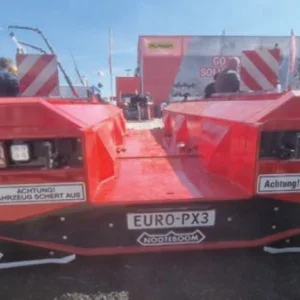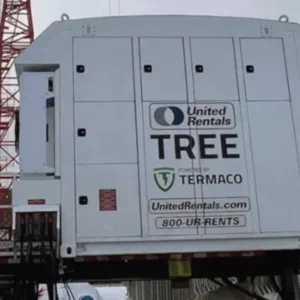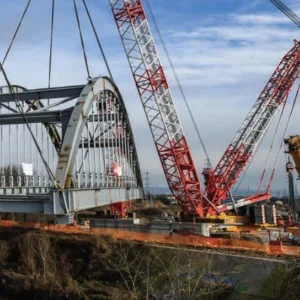Any project involving the lifting or moving of a massive object is a spectacular sight, whether cranes, jacks or strand jacks are used. Transrig, of Norway, was involved in a job that needed all these methods. The contract was to perform the load out, delivery on a semi-submersible platform, and installation of a 1,700t and 62m high drilling rig for Stena Don.
The rig was constructed in Grimstad, Norway, by Nymo. The contract stated that Nymo had to deliver and install the drilling rig in one piece, and it was decided that the rig would be installed using push-up towers. Transrig was contacted to perform the massive lift, which would be done in five stages. Firstly, the rig was loaded out using self-propelled platform trailers and then lifted 38m above the barge deck by two 600t and two 750t push up towers. The drilling rig then had to be skidded along a temporary skid track at the top of the platform, and finally lowered from the upper deck to the main deck.
After months of planning, the project started in earnest in August 2000 when the drilling rig was loaded out using Sarens self-propelled platform trailers – 72 axle lines in all. In the meantime, construction of the semi-submersible platform by Kvaerner Warnow Werft in Germany had been completed and it was in the dock waiting for the drilling rig to be lifted onto it.
The next stage of the lift was the positioning of the aft push-up towers and Sarens climbing jacks. In a combined lift, the drilling rig was lifted high enough to fit the front push-up towers underneath it, and the load was transferred to the four towers. Once the rig had been lifted to a height of 38m, and the temporary skidway had been installed, the rig was put directly above its final location by push jacks. From here, six 600t climbing jacks which had been placed underneath the final 20m stretch of the skidway, lowered the rig into position.
It was set down in its final position within 7mm of its theoretical location and 1mm transversely. The drill-centre of the rig was also measured at 1mm off the vertical axis over a height of 50m.
Baldwins’ big lifters
On the grounds of the new Science Centre in Glasgow, Scotland, rental company Baldwins deployed a 1,000t-capacity Liebherr LTM 1800D telescopic mobile for the construction of an observation tower. The 108m-high tower comprised eight sections, each weighing 28t. To lift one section on top of the other, the crane operated with its telescopic boom fully extended to 60m, as well as a 31.5m derrick boom and a 59m-long lattice jib.
Elsewhere, in Teeside in the north east of England, Baldwins was called on to lift a bascule bridge onto a barge in January for its onward transport to Canary Wharf in east London. The steel bridge weighed 400t and measured 22m in length, 15m in width and 8m in depth. The bridge had been fabricated by in Teesside by Heerema Hartlepool for Cleveland Bridge. Baldwins used a 1,200t-capacity Liebherr LR 1800 crawler to lift the bridge from a self-propelled modular trailer and onto a barge. As the photograph below shows, the shape of the structure meant that special care had to be taken with the slinging and lifting, using spreaders and connecting link plates.
All Erection action
US crane rental company All Erection was called on to work on the construction of an overpass bridge on the Route 88 Mon-Fayette Expressway near Pittsburgh, Pennyslvania. The bridges were being built as part of a $49.2m contract awarded to Dick Corporation.
All Erection deployed one of its Manitowoc 21000 crawlers rigged with 110m of boom to lift and place beams onto the concrete structure of the overpass. The huge beams weighed around 285t and were hoisted 77m to be put in place.
When the overpass is completed, it will stand approximately 15m above the Wheeling and Lake Erie Railroad trestle and will rank as the second highest crossing in Pennyslvania.
Kitzingen’s bridge
Another bridge installation, this time in Germany, also required a heavylift crane to help out.
In November 2000 crane and haulage companies Riga and Sarens were involved in the task of transporting a bridge to the small town of Kitzingen on the river Main and lifting it into place. Installation of the 530t and 110m-long bridge was delayed by disagreements over engineering plans. Eventually, at the start of November, an 800t-capacity Liebherr LRD 1800 crawler crane was brought along the river by barge and unloaded at Kitzingen where its tracks and superstructure were added. The steel bridge had already been assembled and was waiting the arrival of the crane.
The bridge was installed by the crawler crane sited on the east bank of the river, aided by a double pontoon on the other side to share the weight. The pontoon was supplied by Sarens, which had also provided a pair of eight-axle self-propelled modular trailers (SPMTs) to assist in manoeuvring the bridge when it was on the river bank.
The river banks had to be reinforced with concrete, and a roadway was constructed to support the 600t weight of the crane.
The LRD 1800 was fitted with 70m of boom, a 42m derrick boom and suspended counterweight. The crane moved 10m forward to the edge of the river, and lifted the bridge to a height of 15m, and positioned it on the pontoon.
As the lifting radius increased, the counterweight had to be increased, and when the radius reached 34.5m, the LRD 1800 was carrying 544t of counterweight. As weight was transferred from the crane to the pontoon, the suspended counterweight on the crane was reduced in steps and water was pumped out of the pontoon to keep it level. The pontoon was steered and positioned by rope winches on the opposite side of the river, and at times had only 30cm of water underneath it because of the weight on top.
Titan lands in hot water
American maritime salvage company Titan Maritime was given the task of raising a sunken barge carrying rocks and boulders that had capsized in the Persian Gulf in February 2000. The Alia had sunk just off the Mina Saqr Port in Ras Al Khaimah, United Arab Emirates, with her stern stuck in a seabed trench over a length of 30m. The hull of the barge had imploded and cracked open, and there was severe damage to the internal structure. Titan decided to use its Titan Pullers system because a floating crane would have been impractical in the open ocean.
The Titan Pullers system, designed in-house by Titan, is a series of linear hydraulic chain pullers, each individual puller capable of lifting 300t. One of the advantages that the system has over floating cranes, as well as the greater lifting capacity, is that the pullers can be spread out over a larger portion of whatever is being lifted.
In October 2000, 14 Titan Pullers were positioned on two deck barges, giving a combined lifting force of 4,200t, and divers burned lifting points on each side of the sunken barge. The wreck was cut in half and the forward section lifted and taken underwater to another site where it was to be left to serve as a fish sanctuary.
The lowering operation for the first section of the vessel was disrupted when an Omani gunboat approached the Titan crew, protesting that the wreck was being disposed of in Omani waters. The Titan team had been completely unaware of a border dispute between Oman and the UAE, and the gunboat took salvage master Guy Wood back to Oman for questioning about the incident.
Wood returned from Oman the next day and a new site for the wreck of the Alia was agreed by the UAE authorities. The aft section of the barge was then raised and both sections were placed at the new location.
Prangle’s heavy journey
German crane rental, transport and haulage company Prangl Gesellschaft completed a contract to transport three parts of a gas reactor across Austria in October last year. The reactor had been manufactured in Finland, and had arrived at the port of Albern in Vienna via inland waterways from Rotterdam.
The largest of the three parts of the reactor weighed 146t, and the others weighed 27t and 80t. The parts were loaded onto Goldhofer trailers in the Netherlands, the largest piece loaded onto a 16-axle heavy duty combination transporter. The route that was planned for the convoy had been throughouly examined by Prangl beforehand.
One of the problems was that the heavy-duty combination carrying the largest piece of the load needed to be joined so that it complied with axle-load regulations. At the same time, the combination had to be as short as possible to negotiate some of the narrow turns on the route.
As the convoy made its way across Austria, another group travelled in front of it, taking down traffic lights and street signs and covering flowerbeds and traffic islands with steel plates. Wooden planks were also placed on some of the more extreme corners to allow the convoy a wider turning circle.






